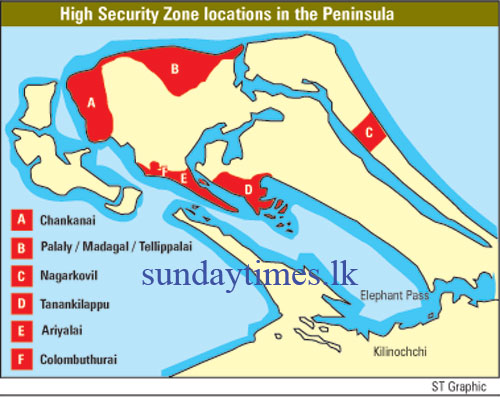President Mahinda Rajapaksa will today announce that High Security Zones in the Jaffna peninsula will be dismantled. They will be replaced by buffer zones extending 300 metres outwards from military installations.
Minister and EPDP leader Douglas Devananda told the Sunday Times yesterday that Jaffna’s Government Agent was now working on the areas where immediate re-settlement of civilians displaced by the separatist war would begin. These areas would include Palaly, Madagal, Chankanai, Ariyalai, Colombuthurai, Tanankilappu, Nagarkovil and Tellippalai.
President's Rajapaksa's impending announcement is one step ahead of his rival at the presidential election. The common opposition candidate Gen. Sarath Fonseka, announced in Jaffna last week he would remove the High Security Zones and allow civilians to get back to their homes.
He explained that the HSZs could have been removed earlier as the camps were no longer under threat of artillery fire.
The Government Agent this week has been instructed by the government to work on a programme to identity the areas where the resettlement should be carried out with immediate effect.
The withdrawal of the security zones will enable 80,000 displaced civilians to return to their homes. The HSZs extend to an area of 42 square kilometres in the Jaffna peninsula. Bulldozers and heavy equipment have been kept ready to be used to remove bunds and bunkers in the HSZs.
The Jaffna Divisional Secretariat was yesterday hurriedly processing applications by civilians who wanted to return to their homes in the HSZs. Jaffna’s Additional Government Agent Rubini Varthalingam said there would no HSZs and only a ‘Defence Front Line’ would be maintained.
Earlier, the Supreme Court had ruled that some of the families could be resettled in designated areas. A five-member Committee headed by Jaffna Government Agent K. Ganesh was appointed two years ago to study the resettlement process. |


